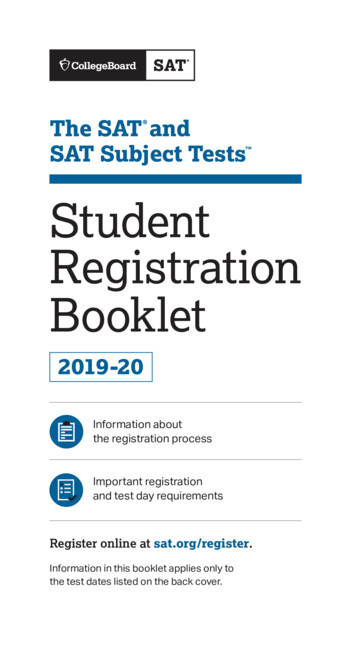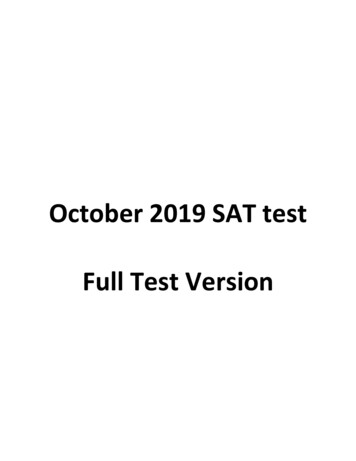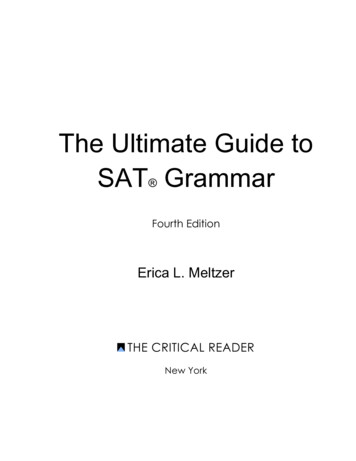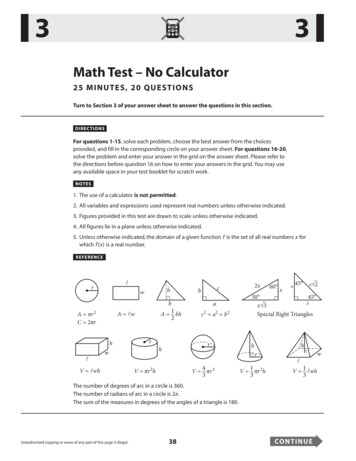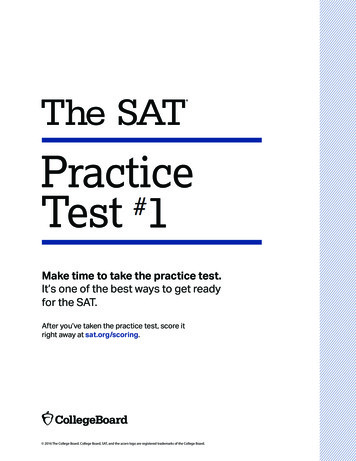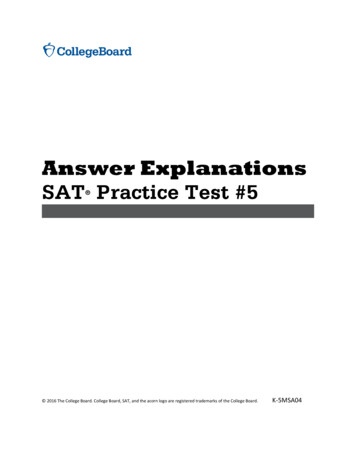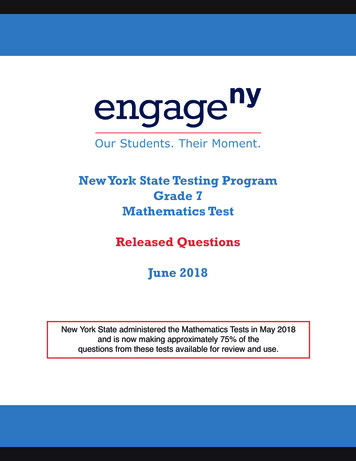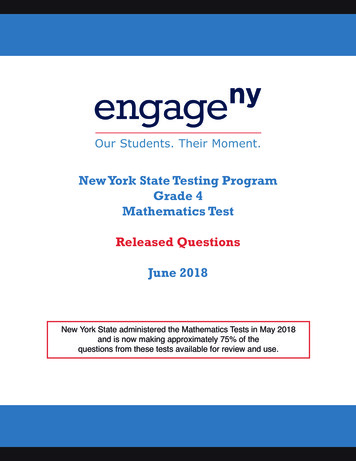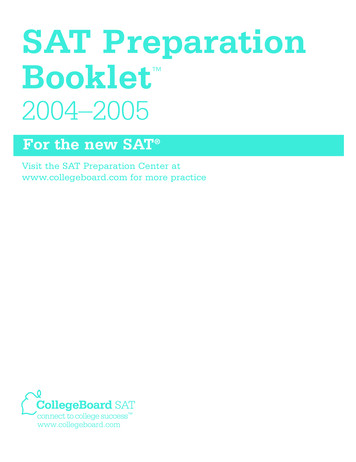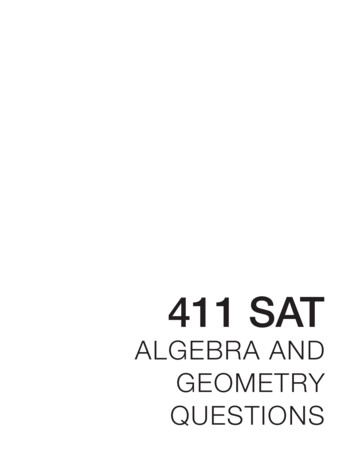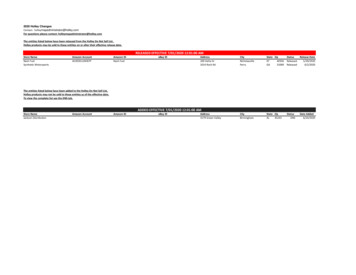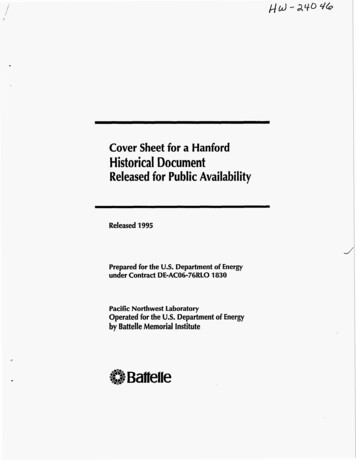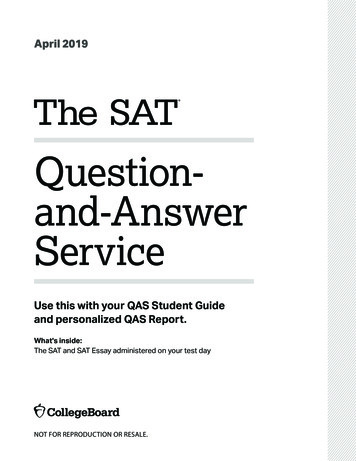
Transcription
April 2019Questionand-AnswerServiceUse this with your QAS Student Guideand personalized QAS Report.What's inside:The SAT and SAT Essay administered on your test dayNOT FOR REPRODUCTION OR RESALE.
Question-and-Answer ServiceABOUT COLLEGE BOARDCollege Board is a mission-driven not-for-profit organization that connectsstudents to college success and opportunity. Founded in 1900, CollegeBoard was created to expand access to higher education. Today, themembership association is made up of over 6,000 of the world’s leadingeducational institutions and is dedicated to promoting excellence andequity in education. Each year, College Board helps more than sevenmillion students prepare for a successful transition to college throughprograms and services in college readiness and college success—includingthe SAT and the Advanced Placement Program . The organization alsoserves the education community through research and advocacy onbehalf of students, educators, and schools. For further information, visitcollegeboard.org.SAT CUSTOMER SERVICEYou can reach us from 8 a.m. to 9 p.m. ET (9 a.m. to 7 p.m. after theJune test through August 19).Phone: 866-756-7346International: 1-212-713-7789Email: sat@info.collegeboard.orgMail: College Board SAT Program, P.O. Box 025505, Miami, FL 33102TABLE OF CONTENTS1 Introduction2 Reading Test18 Writing and Language Test34 Math Test – No Calculator41 Math Test – Calculator56 Essay 2019 College Board. College Board, Advanced Placement Program, SAT, and the acorn logo are registered trademarks of College Board.Visit College Board on the web: collegeboard.org.April QAS 4/9/19ii
Question-and-Answer ServiceIntroductionCongratulations on taking the SAT ! This booklet contains the SAT youtook in April 2019, including (if you took the SAT Essay) an Essay promptyou responded to. This booklet contains every question and prompt thatwas scored.As part of the Question-and-Answer Service (QAS) you also have received:1.2.A customized report that lists the following details about each question: answer you gave best or correct answer question type difficulty levelA QAS Student Guide that explains your scores and how tointerpret them.The test begins on the next page.April QAS 4/9/191
11Question-and-Answer ServiceReading Test65 M I N U TES, 5 2 QUESTIONSTurn to Section 1 of your answer sheet to answer the questions in this section.Each passage or pair of passages below is followed by a number of questions. After readingeach passage or pair, choose the best answer to each question based on what is stated orimplied in the passage or passages and in any accompanying graphics (such as a table orgraph).This passage is adapted from Cristina Henríquez, The Book ofUnknown Americans. 2014 by Cristina Henríquez.Line510152025One afternoon I made chicharrones and carriedthem over to Celia’s apartment.She clapped her hands together in delight whenshe saw me and motioned for me to come inside.“These are for you,” I said, holding out a foilcovered plate.She lifted a corner of the foil and sniffed.“Sabroso,” she said.I loved how full her home felt, embroideredpillows on the couches, a curio stacked with milkglass bowls and recuerdos and folded tablecloths, redvotives along the windowsills, spidery potted plants,woven rugs, unframed posters of Panamá beaches onthe walls, a box of rinsed bottles on the floor, a smallradio on top of the refrigerator, a plastic bag filledwith garlic hanging from a doorknob, a collection ofspices clustered on a platter on the counter. The greataccumulation of things almost hid the cracks in thewalls and the stains on the floor and the scratchesthat clouded the windows.“Mi casa es tu casa,” Celia joked as I lookedaround. “Isn’t that what the Americans say?”She poured cold, crackling Coca-Colas for both ofus, and we sat on the couch, sipping them and takingsmall bites of the chicharrones. She looked just as shehad the first time I met her: impeccably pulledtogether, with a face full of makeup, fuchsia lips,chestnut-brown chin-length hair curled at the ends.Questions 1-10 are based on the followingpassage.303540455055and tucked neatly behind her ears, small goldearrings. So unlike most of my friends at home, whoused nothing but soap on their faces and aloe ontheir hands and who kept their hair pulled intoponytails, like mine, or simply combed after it hadbeen washed and left to air-dry.Celia told me about the provisions we would needfor winter—heavy coats and a stack of comfortersand something called long underwear that made melaugh when she tried to describe it—and about aplace called the Community House where theyoffered immigrant services if we needed them. Shegossiped about people in the building. She told methat Micho Alvarez, who she claimed always wore hiscamera around his neck, had a sensitive side, despitethe fact that he might look big and burly, and thatBenny Quinto, who was close friends with Micho,had studied to be a priest years ago. She said thatQuisqueya dyed her hair, which was hardlynews—I had assumed as much when I met her. “It’sthe most unnatural shade of red,” Celia said. “Rafaelsays it looks like she dumped a pot of tomato sauceon her head.” She chortled. “Quisqueya is abusybody, but it’s only because she’s so insecure. Shedoesn’t know how to connect with people. Don’t lether put you off.”Celia began telling me about when she and Rafaeland her boys had come here from Panamá, fifteenyears ago, after the invasion.“So your son, he was born there?” I asked.April QAS 4/9/19Unauthorized copying or reuse of any part of this page is illegal.2CO NTI N U E
165707580859095“I have two boys,” she said. “Both of them wereborn there. Enrique, my oldest, is away at college ona soccer scholarship. And there’s Mayor, who youmet. He’s nothing at all like his brother. Rafa thinkswe might have taken the wrong baby home from thehospital.” She forced a smile. “Just a joke, of course.”She stood and lifted a framed picture from theend table. “This is from last summer before Enriquewent back to school,” she said, handing it to me.“Micho took it for us.”In the photo were two boys: Mayor, whom Irecognized from the store, small for his age withdark, buzzed hair and sparkling eyes, and Enrique,who stood next to his brother with his arms crossed,the faint shadow of a mustache above his lip.“What about you?” Celia asked. “Do you haveother children besides your daughter?”“Only her,” I said, glancing at my hands aroundthe glass. The perspiration from the ice had left a ringof water on the thigh of my pants.“And she’s going . . .” Celia trailed off, as thoughshe didn’t want to say it out loud.“To Evers.”Celia nodded. She looked like she didn’t knowwhat to say next, and I felt a mixture ofembarrassment and indignation.“It’s temporary,” I said. “She only has to go therefor a year or two.”“You don’t have to explain it to me.”“She’s going to get better.”“I’ve heard it’s a good school.”“I hope so. It’s why we came.”Celia gazed at me for a long time before she said,“When we left Panamá, it was falling apart. Rafa andI thought it would be better for the boys to grow uphere. Even though Panamá was where we had spentour whole lives. It’s amazing, isn’t it, what parentswill do for their children?”She put her hand on mine. A benediction. Fromthen, we were friends.601Question-and-Answer Service1The description of Celia’s apartment in lines 9-20 isprimarily intended toA) evoke a sense of coziness and comfort.B) reflect the hectic and unpredictable nature of lifein Celia’s building.C) extol the ready availability of goods in the UnitedStates.D) establish that Celia is an avid collector.2According to the passage, which fact about Celia’sneighbors does the narrator know before she visitsCelia’s apartment?A) Micho Alvarez and Benny Quinto are closefriends.B) Benny Quinto once studied to be a priest.C) Micho Alvarez has a sensitive side.D) Quisqueya dyes her hair.3When Celia tells the narrator not to let Quisqueya“put you off” (line 54), she most nearly means thatthe narrator should notA) be offended by Quisqueya.B) be deceived by Quisqueya.C) let Quisqueya avoid her.D) let Quisqueya impose on her.April QAS 4/9/19Unauthorized copying or reuse of any part of this page is illegal.3CO NTI N U E
11Question-and-Answer ServiceWhich choice best describes the narrator’srelationship with Celia’s sons?A) The narrator knows Celia’s sons because they arefriends with the narrator’s daughter.B) The narrator’s daughter attends school withMayor.C) The narrator has seen Mayor in person, but shehas seen Enrique only in Celia’s photo.D) The narrator has seen Enrique play soccer, butshe has never seen Mayor.5Which choice provides the best evidence for theanswer to the previous question?A) Line 58 (“So . . . asked”)B) Lines 59-62 (“I have . . . brother”)C) Lines 65-68 (“She stood . . . us”)D) Lines 74-75 (“What . . . daughter”)6Celia recounts Rafa’s joke (lines 61-64) primarily inorder toA) endear Rafa to the narrator.B) impress the narrator with her quick wit.C) stress how different her sons are.D) defuse a tense situation.7Based on the passage, it is most reasonable to inferthat Celia knows the answer to which question aboutthe narrator’s family before the narrator visits herapartment?A) How many children does the narrator have?B) Where does the narrator’s daughter go toschool?C) What is the narrator’s profession?D) How long have the narrator and her family livedin the United States?.48Which choice provides the best evidence for theanswer to the previous question?A) Lines 79-80 (“And . . . loud”)B) Lines 82-84 (“Celia . . . indignation”)C) Lines 92-94 (“When . . . here”)D) Lines 95-96 (“It’s amazing . . . children”)9Based on the passage, it can reasonably be inferredthat Celia tells the narrator about leaving Panama(lines 91-96) primarily toA) encourage the narrator to share her story ofimmigration.B) remind the narrator of the reasons they bothimmigrated to the United States.C) console the narrator by describing how Celia’sfamily has prospered since they left.D) assure the narrator that she understands andempathizes with her.10In line 97, the word “benediction” primarily serves toA) stress the importance of religion to Celia and thenarrator.B) imply that the narrator views Celia as anauthority figure.C) emphasize how meaningful Celia’s gesture wasfor the narrator.D) demonstrate how eloquently Celia spoke duringher conversation with the narrator.April QAS 4/9/19Unauthorized copying or reuse of any part of this page is illegal.4CO NTI N U E
1Line51015202530354045Voters need to understand the prosaic details ofcomplex policies. Most have staked out positions onthese issues, but they are not often reasonedpositions, which take hard intellectual work. Mostcitizens opt instead for simplistic explanations,assuming wrongly that they comprehend the nuancesof issues.Psychological scientists have a name for thiseasy, automatic, simplistic thinking: the illusion ofexplanatory depth. We strongly believe that weunderstand complex matters, when in fact we areclueless, and these false and extreme beliefsshape our preferences, judgments, and actions—including our votes.Is it possible to shake such deep-rootedconvictions? That’s the question that PhilipFernbach, a psychological scientist at the Universityof Colorado’s Leeds School of Business, wanted toexplore. Fernbach and his colleagues wondered ifforcing people to explain complex policies indetail—not cheerleading for a position but reallyconsidering the mechanics of implementation—might force them to confront their ignorance andthus weaken their extremist stands on issues. Theyran a series of lab experiments to test this idea.They started by recruiting a group of volunteers intheir 30s—Democrats, Republicans, andIndependents—and asking them to state theirpositions on a variety of issues, from a national flattax to a cap-and-trade system for carbon emissions.The volunteers indicated how strongly they felt abouteach issue and also rated their own understanding ofthe issues. Then the volunteers were instructed towrite elaborate explanations of two issues. If the issuewas cap and trade, for example, they would firstexplain precisely what cap and trade means, how it isimplemented, whom it benefits and whom it couldhurt, the sources of carbon emissions, and so forth.They were not asked for value judgments about thepolicy or about the environment or business, butonly for a highly detailed description of themechanics of the policy in action.Let’s be honest: Most of us never do this.Fernbach’s idea was that such an exercise wouldforce many to realize just how little they really know505560657075about cap and trade, and confronted with their ownignorance, they would dampen their ownenthusiasm. They would be humbled and as a resulttake less extreme positions. And that’s just whathappened. Trying—and failing—to explain complexpolicies undermined the extremists’ illusions aboutbeing well-informed. They became more moderate intheir views as a result.Being forced to articulate the nuts and bolts of apolicy is not the same as trying to sell that policy.In fact, talking about one’s views can oftenstrengthen them. Fernbach believes it’s the slow,cognitive work—the deliberate analysis—thatchanges people’s judgments, but he wanted to checkthis in another experiment. This one was very similarto the first, but some volunteers, instead ofexplaining a policy, merely listed reasons for liking it.The results were clear. Those who simply listedreasons for their positions—articulating theirvalues—were less shaken in their views. Theycontinued to think they understood the policies intheir complexity, and, notably, they remainedextreme in their passion for their positions.Polarization tends to reinforce itself. People areunaware of their own ignorance, and they seek outinformation that bolsters their views, often withoutknowing it. They also process new information inbiased ways, and they hang out with people likethemselves. All of these psychological forces increasepolitical extremism, and no simple measure willchange that. But forcing the candidates to provideconcrete and elaborate plans might be a start; it givescitizens a starting place.Figure 1Mean self-rating (scale of 1 to 7;7 greatest understanding)This passage is adapted from Wray Herbert, “ExtremistPolitics: Debating the Nuts and Bolts.” 2012 byTheHuffingtonPost.com, Inc.Questions 11-21 are based on the followingpassage and supplementary material.1Question-and-Answer ServiceVolunteers’ Mean Self-Ratings forUnderstanding a Policy7.06.05.0before taskafter task4.03.02.01.0analyze andexplain policylist reasons foror against policyTaskApril QAS 4/9/19Unauthorized copying or reuse of any part of this page is illegal.5CO NTI N U E
11Question-and-Answer ServiceMean self-rating (scale of 0 to 3;3 strongest position)Volunteers’ Mean Self-Ratings forPosition on Policy3.02.52.0before taskafter task1.51.00.50analyze andexplain policylist reasons foror against policyTaskFigures adapted from Philip Fernbach et al., “Political Extremism IsSupported by an Illusion of Understanding.” 2013 by PhilipFernbach et al.11A central idea discussed in the passage is thatA) articulating the reasons for holding an opinioncan cause people to decide that they are wrong.B) the process of describing an issue in detail canmake people more moderate in their views aboutthe issue.C) most people are not truly interested inunderstanding complex ideas.D) people are likely to understate their mostpassionately held positions to avoid offendingothers.Figure 212Over the course of the passage, the main focus shiftsfromA) a discussion of a long-standing problem, to areport that discredits previous attempts toaddress that problem, and then to a proposal forfuture action.B) an introduction of a phenomenon, to adescription of experiments concerning thatphenomenon, and then to a recommendationbased on the results of the experiments.C) an explanation of two competing theories for acertain behavior, to a recap of a study designedto determine which theory is correct, and then toa general account of a field’s future.D) an observation of a trend, to an analysis of itscauses, and then to a proposal for a researchstudy to validate the analysis.13As used in line 9, “illusion” most nearly meansA) misconception.B) dream.C) charade.D) phantom.14As used in line 13, “shape” most nearly meansA) plan.B) model.C) influence.D) modify.April QAS 4/9/19Unauthorized copying or reuse of any part of this page is illegal.6CO NTI N U E
1The main purpose of the fourth paragraph(lines 26-42) is toA) provide support for a theory.B) defend the need for a research study.C) outline the specifics of an experiment.D) discuss the complexity of a particular issue.16The passage implies that when conducting hislaboratory work, Fernbach would have been mostsurprised by which finding?A) No link was found between the complexity of anissue and the strength of the volunteers’positions.B) After volunteers were asked to analyze acomplicated political issue, their understandingof it did not increase.C) When volunteers were asked to list their reasonsfor endorsing a particular policy, their viewswere generally unaffected by the exercise.D) When volunteers were asked questions aboutcomplex issues, those with the most extremeviews were found to have the best overallunderstanding of them.17Which choice provides the best evidence for theanswer to the previous question?A) Lines 26-30 (“They started . . . emissions”)B) Lines 34-38 (“If the . . . forth”)C) Lines 39-42 (“They . . . action”)D) Lines 44-49 (“Fernbach’s . . . positions”).151Question-and-Answer Service18Based on the passage, which action would most likelyreduce political extremism among the citizenry?A) Forming organized groups of people who sharetheir most deeply held convictionsB) Requiring that politicians explain their proposedpolicies in detail before an election is heldC) Promoting awareness of charities that provideopportunities to donate money to worthy butunderfunded causesD) Hosting events that encourage people who holdopposing points of view to interact with oneanother19Which choice provides the best evidence for theanswer to the previous question?A) Lines 65-68 (“They continued . . . positions”)B) Lines 69-72 (“People . . . knowing it”)C) Lines 72-74 (“They . . . themselves”)D) Lines 76-78 (“But forcing . . . place”)April QAS 4/9/19Unauthorized copying or reuse of any part of this page is illegal.7CO NTI N U E
11Question-and-Answer ServiceAccording to figure 1, which statement best describesthe change in the mean self-ratings of the volunteersafter they were asked to analyze and explain a policy?A) They became more extreme in their position onthe policy.B) They became more reluctant to justify aparticular viewpoint.C) They became less confident in theirunderstanding of the policy.D) They became less interested in the policy.21According to both the passage and figure 2, making alist of reasons for or against a policy has little impacton an individual’sA) position on an issue.B) interest in an issue.C) opinion about people holding differing views.D) likelihood to vote in an election.20Questions 22-32 are based on the followingpassage and supplementary material.This passage is adapted from “Rare Woodland Plant Uses‘Cryptic Coloration’ to Hide from Predators.” 2009 byAmerican Journal of Botany, Inc.Line51015202530354045It is well known that some animal species usecamouflage to hide from predators. Individuals thatare able to blend in to their surroundings and avoidbeing eaten are able to survive longer, reproduce, andthus increase their fitness (pass along their genes tothe next generation) compared to those who standout more. This may seem like a good strategy, andfairly common in the animal kingdom, but who everheard of a plant doing the same thing?In plants, the use of coloration or pigmentation asa vital component of acquiring food (e.g.,photosynthesis) or as a means of attractingpollinators (e.g., flowers) has been well studied.However, variation in pigmentation as a means ofescaping predation has received little attention.Matthew Klooster from Harvard University andcolleagues empirically investigated whether the driedbracts (specialized leaves) on a rare woodland plant,Monotropsis odorata, might serve a similar purposeas the stripes on a tiger or the grey coloration of thewings of the peppered moth: namely, to hide.“Monotropsis odorata is a fascinating plantspecies, as it relies exclusively upon mycorrhizalfungus, that associates with its roots, for all of theresources it needs to live,” notes Klooster. “Becausethis plant no longer requires photosyntheticpigmentation (i.e., green coloration) to produce itsown energy, it is free to adopt a broader range ofpossibilities in coloration, much like fungi oranimals.”Using a large population of Monotropsis odorata,Klooster and colleagues experimentally removed thedried bracts that cover the 3- to 5-cm tall stems andflower buds of these woodland plants. The bracts area brown color that resembles the leaf litter fromwhich the reproductive stems emerge and cover thepinkish-purple colored buds and deep purple stems.When Klooster and colleagues measured thereflectance pattern (the percentage of light reflectedat various wavelengths) of the different plant parts,they indeed found that the bracts functioned ascamouflage, making the plant blend in with itssurroundings; the bract reflectance pattern closelyresembled that of the leaf litter, and both differedfrom that of the reproductive stem and flowersApril QAS 4/9/19Unauthorized copying or reuse of any part of this page is illegal.8CO NTI N U E
16570Reflectance Patterns of Leaf Litterand Monotropsis odorata Structuresleaf litterbractflower petalreproductivestem4540Percent reflectance60Figure 135302520151050300400500600700Wavelength (nanometers)Figure 2Mean proportion of floral stemswith herbivore damage per plant55.50hidden underneath the bracts. Furthermore, theyexperimentally demonstrated that this camouflageactually worked to hide the plant from its predatorsand increased its fitness. Individuals with intactbracts suffered only a quarter of the herbivoredamage and produced a higher percentage of maturefruits compared to those whose bracts were removed.“It has long been shown that animals use crypticcoloration (camouflage) as a defense mechanism tovisually match a component of their naturalenvironment, which facilitates predator avoidance,”Klooster said. “We have now experimentallydemonstrated that plants have evolved a similarstrategy to avoid their herbivores.”Drying its bracts early to hide its reproductiveparts is a good strategy when the stems are exposedto predators for long periods of time: all the otherspecies in the subfamily Monotropoideae havecolorful fleshy bracts and are reproductively activefor only a quarter of the length of time. Somewhatparadoxically, however, Monotropsis odorata actuallyrelies on animals for pollination and seed dispersal.How does it accomplish this when it is disguised asdead leaf material and is able to hide so well? Theauthors hypothesize that the flowers emit highlyfragrant odors that serve to attract pollinators andseed dispersal agents; indeed they observed bumblebees finding and pollinating many reproductivestems that were entirely hidden by the leaf litter itself.1Question-and-Answer Service0.40Floral Herbivore Damage toMonotropsis odorata 62007plants with bracts intactplants with bracts removedFigures adapted from Matthew R. Klooster et al., “Cryptic BractsFacilitate Herbivore Avoidance in the Mycoheterotrophic PlantMonotropsis odorata.” 2009 by American Journal of Botany, Inc.April QAS 4/9/19Unauthorized copying or reuse of any part of this page is illegal.9CO NTI N U E
11Question-and-Answer ServiceThe main purpose of the passage is toA) contrast the activities of plant species that rely onphotosynthesis with the activities of those thatdo not.B) explore the attempts of scientists to understandthe means by which plants attract pollinators.C) describe a study illuminating a defensive strategyof a particular species of plant.D) explain the results of experiments comparing thefunction of color in plants and in animals.23Which choice best supports the idea that the abilityof a species to use camouflage effectively can providean evolutionary advantage?A) Lines 1-2 (“It is . . . predators”)B) Lines 2-7 (“Individuals . . . more”)C) Lines 7-9 (“This . . . thing”)D) Lines 10-13 (“In plants . . . studied”)24The passage indicates that compared with otherfunctions of coloration in plants, camouflage inplants hasA) provided scientists with a deeper understandingof potential food sources.B) made use of a wider variety of distinctive shadesof colors.C) proved to be a less effective defense againstpredators.D) been the subject of a smaller number of scientificinvestigations.2225In lines 20-21, the references to the tiger and themoth serve mainly toA) provide examples of animal species withcharacteristics analogous to those of the plantinvestigated in the passage.B) offer a contrast between the defensive strategiesof animals and the strategies of the plantexamined in the passage.C) suggest a new possibility for applying the plantresearch discussed in the passage to the animalworld.D) defend the work described in the passage againstthose who had criticized the inclusion of certainanimals in the interpretation of the findings.26It can most reasonably be inferred from the passagethat the nutrient requirements of many plants havethe consequence ofA) exaggerating the plants’ coloration patterns.B) limiting the plants’ defensive options.C) increasing the plants’ energy consumption.D) narrowing the plants’ potential habitats.27Which choice provides the best evidence for theanswer to the previous question?A) Lines 16-21 (“Matthew . . . hide”)B) Lines 22-25 (“Monotropsis . . . Klooster”)C) Lines 25-30 (“Because . . . animals”)D) Lines 31-34 (“Using . . . plants”)April QAS 4/9/19Unauthorized copying or reuse of any part of this page is illegal.10CO NTI N U E
1As used in line 28, “broader” most nearly meansmoreA) extensive.B) obvious.C) tolerant.D) spacious.29As used in line 48, “worked” most nearly meansA) changed.B) influenced.C) functioned.D) manipulated.30According to figure 1, the percent reflectance of theflower petal of the Monotropsis odorata plants forlight at a wavelength of 600 nanometers wasapproximatelyA)5 percent.B) 10 percent.C) 20 percent.D) 30 percent.281Question-and-Answer Service31Which statement about reflectance patterns inMonotropsis odorata is best supported by the datapresented in figure 1?A) The flower petal reflectance pattern tracksclosely with the bract reflectance pattern.B) The leaf litter reflectance pattern showsdecreases in relation to increases in the flowerpetal reflectance pattern.C) The reproductive stem reflectance pattern ismost similar to the leaf litter reflectance pattern.D) The bract ref
SAT CUSTOMER SERVICE You can reach us from 8 a.m. to 9 p.m. ET (9 a.m. to 7 p.m. after the June test through August 19). Phone: 866-756-7346 International: 1-212-713-7789 Email: sat@info.collegeboard.org Mail: College Board SAT Program, P.O. Box 025505, Miami, FL 33102 TABLE OF CONTENTS 1 Introduction 2 Reading Te
